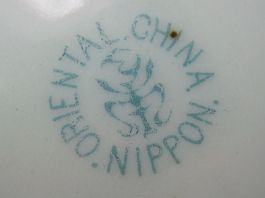Made In Nippon Ceramic Marks

During world war ii most ceramics factories for exports ceased except noritake see japanese ceramics of the last 100 years by irene stitt pg 167.
Made in nippon ceramic marks. A reproduction wholesaler is now selling ceramic items with a mark that is virtually identical to original marks found on ca. Pre 1921 items were not marked made in japan. Latest fake nippon mark identical to old. A few real life samples of genuine moorcroft pottery marks.
The first fake marks of the 1980s were on blanks with decorations unlike that of original nippon and were relatively easy to identify. The new mark fig. In addition to the nippon mark pieces made for the u s. Market from 1911 to 1921 often have the letter m in a wreath.
Made in japan marks the following marks are from made in japan pieces. A helpful dating tip in the labyrinth of japanese marks is it is generally accepted that marks that include dai nippon in japanese characters on the whole date to the meiji 1868 to 1912 period reflecting the greatly increased nationalism of the time. When you see a nippon mark on the underside of a base of a piece of ceramic you know that you have a piece that was made in japan. Since the mid 1990s there have been a wide number of faked nippon marks appearing on new porcelain.
Pieces made for the british market are often stamped with an x with a vertical bar through the center while pieces for the domestic japanese market were usually oriental in design and back stamped with a. From 1921 1941 wares from japan exported to the united states had to be marked japan or made in japan. Nippon is the japanese name for japan in 1921 the official country of origin name. There seems to be no significance in color of the text as to age.
1 is the same size and color as the original. The range of moorcroft pottery marks begins with william moorcroft s time at the mackintyre pottery and covers the 100 year history of design and ownership by william his son walter moorcroft other more current owners and marks of artists and designers from the moorcroft design studio. Japan made in japan. Marks on export porcelain.
Mckinley tariff act which forbade the import of items that weren t plainly marked stamped branded or labeled in legible english words. The name nippon was chosen for items coming from japan. After 1921 a lot of countries marked them either japan or nippon. Simply nippon means japan and while the nippon mark served its purpose to comply with the mckinley tariff act of 1891 for the next thirty years customs officials decided in 1921 that any piece.
The mark is the so called green wreath mark shown in fig. Nippon porcelain refers to vases teapots wall plaques humidors and other ceramic objects stamped with the word nippon on their bases the practice began in 1891 in response to the u s. Many early japanese pottery marks were hand painted as they were viewed as a signature. In 1891 the mckinley tariff act was instated requiring items imported into the united states to be marked in english with the country of origin.


















